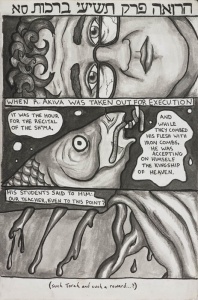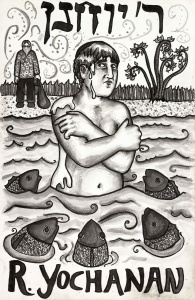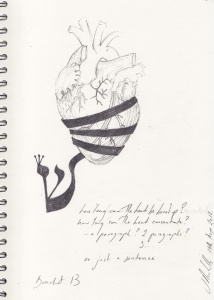Tosafot at Ein Harod
Tosafot: Women Drawing the Talmud at the Mishkan Le’Omanut in Ein Harod, Israel showcases the cutting edge work of two women artists significantly contributing to the lively and disparate Jewish cultural scene we are fortunate to inhabit. There is plenty of room for both avant-garde artworks and respectable history in the hallowed halls of contemporary Jewish cultural institutions; as evidenced in two current exhibitions half a world apart. Tosafot: Women Drawing the Talmud at the Mishkan Le’Omanut in Ein Harod, Israel showcases the cutting edge work of two women artists.

The ostensible outsider frequently has the privilege of seeing the exclusive inner sanctum with fresh and unbiased eyes. Artist’s initial encounters with the Talmud are equally blessed. Yonah Lavery-Yisraeli and Jacqueline Nicholls’ multiple works at Mishkan Le’Omanut shine in such a light. Lavery’s Martyrdom of Rabbi Akiva is perhaps the most moving and disturbing image I have seen created of that horrific event. She takes the text from Brochos 61b: “When R. Akiva was taken out for execution it was the hour for the recital of the Sh’ma and while they combed his flesh with iron combs, he was accepting on himself the Kingship of Heaven. His students said to him: ‘Our teacher, even to this point?’” Her image is in three parts following the comic book format she has adopted to reappraise the rarified world of Talmud study. The bespeckled clean-shaven contemporary fellow seen sideways is Akiva himself, his glasses already cracked, as he is about to meet his end. On the bottom is a depiction of blood flowing out of his flesh from the iron combs, tracing the lines of tefillin straps on his arm that bring to mind that indeed it was “the time to say the Sh’ma.” Finally the fish cruelly caught on a hook laconically brings to mind the previous Gemara of the parable of the fish and the fox teaching that the study of Torah “is your life and the length of your days” (Deut. 30:20). Lavery’s image pushes back against the Gemara’s optimistic conclusion concerning Akiva’s place in the World to Come. She will not be consoled over the tragic loss of such Torah teachers in the here and now.


Jacqueline Nicholls is engaged in a parallel vastly exhaustive enterprise with her Draw Yomi – Drawing the Talmud. The formidable task of summing up an entire page of Talmud with one drawing and a short and pithy piece of her own commentary; one page a day for the entire Daf Yomi 7 ½ year cycle, started August 3, 2012. Brochot 13 features a stark rendition of a human heart with her terse commentary: “how long can the heart be bound up? how long can the heart concentrate? – a paragraph? 2 paragraphs? …3? or just a sentence?” The Mishnah and following Gemara explore the few permitted interruptions in the recitation of the Shema, as depicted in her drawing by the letter shin and its extension that binds the frail human heart. Additionally her drawing and text echoes the paradigmatic opinion on the page that “mitzvot must be performed with intent,” asking “how long can the heart be bound up?” and thereby cementing together the concept of concentration (bound straps) with intent (the heart). Nicholls’ contemporary text raises the critical question as to exactly how long can we realistically maintain both concentration on the content of a mitzvah and the larger issue of intent. Halacha becomes inquiry.
Sensitively curated by Dvora Liss, the exhibition Tosafot presents the unique quality of visual commentaries to encourage thoughtful contemplation of multiple meanings and connections within the Talmudic text otherwise hidden. Just summon these images when saying the Sh’ma or learning Brochos and their power will become more than clear.
Tosafot
Mishkan Le’Omanut (Museum of Art)
Ein Harod, Israel
Dvora Liss: Judaica Curator: www.museumeinharod.org.il/english
Until April 13, 2014